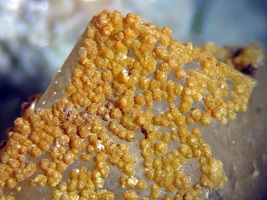
Confidence: 5
Chemistry: Ca3Al7.7Si3P4O23.5 · 8 H2O
Locality: Palermo Mine, N. Groton, NH
Specimen Size: 10 mm field of view. Perhamite balls on quartz crystal termination.
Field Collected: Gene Bearss - 1992
Catalog No.: u1588
Analysis: A November, 2014 EDS analysis indicated the species to be goyazite, (note the strong Sr response). However, multiple follow-on EDS analyses and an XRD analysis revealed the Sr peak was really a silicon peak, so species is perhamite.
A presentation describing the determination of perhamite is included here:
Perhamite Identification (pdf)
Notes: Literature tells us perhamite is structurally related to to crandallite. Goyazite is the strontium analog of crandallite. Gene had this labeled as "Crandallite ?".
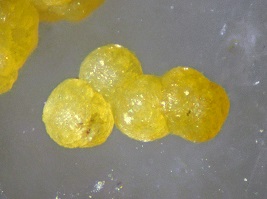
Locality: Palermo Mine, N. Groton, NH
Specimen Size: 1.2 mm perhamite cluster on quartz.
Field Collected: Gene Bearss - 1992
Catalog No.: u1588
Analysis:
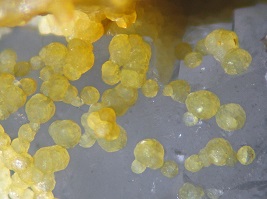
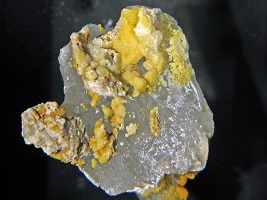
Locality: Palermo Mine, N. Groton, NH
Specimen Size: Top 5 mm field of view. Bottom, 5 mm field of view
Field Collected: Gene Bearss - 1992
Catalog No.:
Analysis:
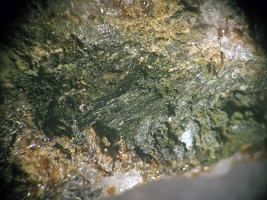
Confidence: 4
Chemistry: Ba(Mn2+,Fe2+)2Fe23+(PO4)3(OH)3
Locality: Palermo Mine, N. Groton, NH
Specimen Size: 8 mm field of view
Field Collected: From a tub of Palermo rocks gifted by Bob Whitmore
Catalog No.: u2062
Analysis: Multiple polished grain probings (BC122) ( EDS analysis1, EDS analysis2 ) indicate the most likely species is perloffite. The analyses indicate a few elements (Ti, Ce, Zr) that are likely miss-assignments by the instrument element peak association software.
Notes: Perloffite has not previously been reported from the Palermo Mine.
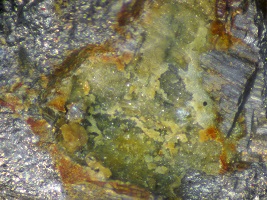
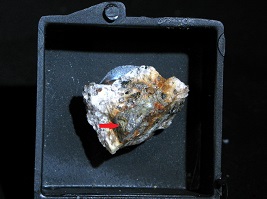
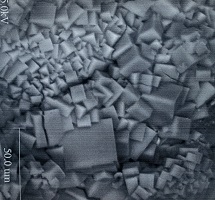
Confidence: 5
Chemistry: KFe3+4(AsO4)3(OH)4 · 6-7 H2O
Locality: Oliver Trench, Moat Mtn., Hale's Location, NH
Specimen Size: 2.5 mm field of view. Yellow-green microcrystaline pharmacosiderite in small arsenopyrite vug. Second view shows complete 12 mm specimen in inch & one-eighth micro-box. Red arrow points to pharmacosiderite zone.
Field Collected: Bob Janules
Owner: Tom Mortimer
Catalog No.: u2089
Notes: EDS analyzed, #BJ0068, J. Nizamoff, Aug, 2003. The largest crystals are about 0.03 mm, below what I can resolve with my photo equipment. The cubic habit of the pharmacosiderite crystals shows clearly in the SEM backscatter image. This image contains the area of the trogerite crystal plate, but it is mostly invisible. It is just to the left of the black dot in the center-left of the image - a small blue-white reflection.
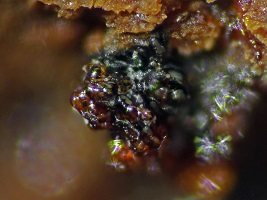
Confidence: 5
Chemistry: (Fe, AsO4, H2O) - mindat.org
Locality: Oliver Trench, Moat Mnt., Hale's Location, NH
Specimen Size: 0.5 mm field of view
Field Collected: Bob Janules
Catalog No.: u2287
Notes: Bob Janules suggested pitticite. The mindat.org formula is given as: (Fe, AsO4, H2O) (?)
These globules are on altering lollingite or arsenopyrite.
Mindat indicates pitticite is:
"An amorphous Fe3+ hydrous arsenate sulphate of questionable validity. Chemical composition appears to be variable."
"Microprobe analyses of 7 pitticites from various localities indicate that it is a gel-like mineral of widely varying composition with no apparent stoichiometry.
Previously reported minor amounts of Si, Ca, P and Al are constituents of pitticites but are non-essential. Pitticite is retained as a generic name for amorphous, gel-like, ferric iron arsenate minerals of varying chemical composition. (P. J. Dunn (1982) New data for pitticite and a second occurrence of yukonite at Sterling Hill, New Jersey. Mineral Mag., 46, 261-264.)"
An Oct. 2019 EDS analysis, normalized for one Fe (BC338) gave FeAs0.6,K0.1O15
Checking with a B&L poloarizing microscope confirmed these globules are amorphous.
Searching the IMA data base for minerals with BC338 analysis chemistry (including H) yields 15 candidates. None of these are pitticite, because I assumed both the Fe and As were "essential" elements to the mineral's composition. I am convinced Bob's identification is correct. This is an excellent example of an experienced collector's intuition for a correct identification.
These lustrous jelly balls are impossible to photo without bright reflections. This photo is the best of four attempts. There are a few mm of these globules on the specimen, but larger area photos are much worse. Sort of like trying to take a photo a group of silver garden balls in sunlight.
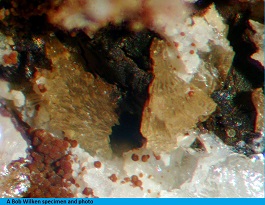
Confidence: 5
Chemistry: PbAl3(PO4)2(OH)5·H2O
Locality: Plume Mine, N. Groton, NH
Specimen Size: 1.2 mm fov with the larger mass (on left side) is 0.5 mm.
Field Collected: Bob Wilken - Owner
Analysis: An EDS analysis of these small crystals indicated plumbogummite. The Si, Ca, and Fe peaks are suspected to be due to surface contamination. A polished grain analysis is needed.
Notes:

Locality: Plume Mine, N. Groton, NH
Specimen Size: 2.0 mm plumbogummite xl mass & zoom view
Field Collected - Owner: Bob Wilken
Notes: Found in the small amount of clean white albitized smaller crystallized pegmatite along w. Childrenite et al. A lead phosphate.
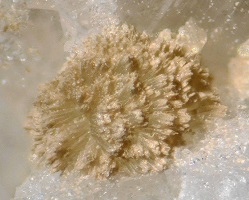
Locality: Plume Mine, N. Groton, NH
Specimen Size: 2.0 mm Plumbogummite xl mass. (Top photo). Two views
Field Collected - Owner: Bob Wilken
Notes: Characteristic appears to be a swept-back and apart. There is a sense of motion present.
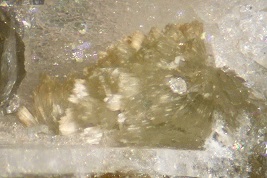
Locality: Plume Mine, N. Groton, NH
Specimen Size: 2.0 mm Plumbogummite mass.
Field Collected - Owner: Bob Wilken
Notes:
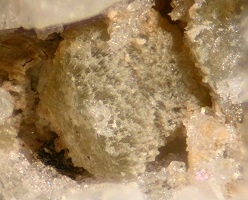
Locality: Plume Mine, N. Groton, NH
Specimen Size: 1.7 mm Plumbogummite mass.
Field Collected - Owner: Bob Wilken
Notes: This may be Greifensteinite Group.
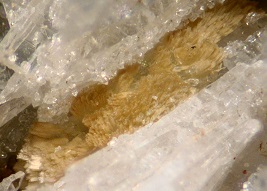
Locality: Plume Mine, N. Groton, NH
Specimen Size: 4.0 mm long Plumbogummite mass.
Field Collected - Owner: Bob Wilken
Notes:
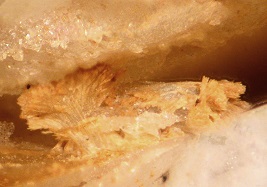
Locality: Plume Mine, N. Groton, NH
Specimen Size: 2.6 mm fov Plumbogummite "brooms."
Field Collected - Owner: Bob Wilken
Notes:
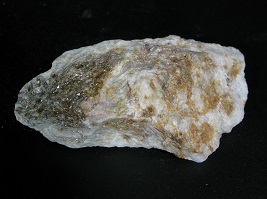
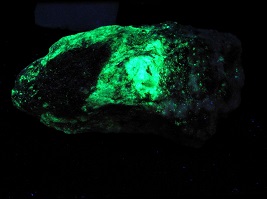
Confidence: 2
Chemistry: (Cs,Na)2(Al2Si4O12)·2H2O
Locality: Parker Mtn. Mine, Center Strafford, NH
Specimen Size: 5.5 cm specimen, daylight and SW UV
Field Collected: Gene Bearss
Catalog No.: 2028
Notes: A polished grain, standardless, quantative EDS analysis (three probings BC93a, b, c set 7) showed a Cs, Al silicate with a Al:Si:Cs ratio of 1:2:0.2 , very low cesium for pollucite. One result also showed small amounts of Na and K (perhaps a perthite inclusion?). Pollucite is not reported as fluorescent. No uranium was detected with a sensitive scintillometer and no autunite flakes could be seen under the microscope. Pollucite has not been previously reported from the Parker Mtn. Mine. A field collector would likely only find this with a UV lamp when night-time collecting. A candidate for XRD. [tm] I did send of a sample for XRD, but the small quantity of my sample gave an inconclusive result. A retry is planned.
Additional research: I now believe that the occurrence of petalite at the Parker Mtn. Mine is in error. The evidence is that the discovered species was pollucite, not petalite. The error originated in a disclosure in the December 1982 Southeastern New Hampshire Mineral Club newslettter Granite Chips wherein it was reported on page 2 that "Roland Bonney ... had picked up substantial quantities of a white mineral with occasional pink areas. He had this checked and it was found to be petalite, the only cesium [tm emphasis] mineral thus found there. It is quite common on the dump and has probably been overlooked as altering feldspar."
The error is that petalite does NOT contain cesium, where-as another white pegmatite mineral, pollucite, DOES!
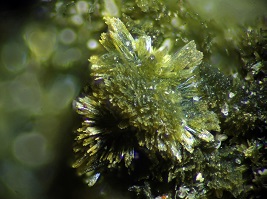
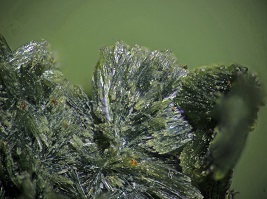
Confidence: 4
Chemistry: Ca2(Fe3+,Mg)Al2(Si2O7)(SiO4)(OH,O)2 · H2O - literature references vary
Locality: Industrial Interchange road cut, Merrimack, NH
Specimen Size: 1 mm field of view top photo, 1.5 mm field of view lower photo
Field Collected: Tom Mortimer - 1990's
Catalog No.: 1150
Notes: Pumpellyite species indicated by EDS analysis, normalized for 3 Si.
APFU from 1st probing: Ca2.45Fe0.35Al2.61Si3O9.3 Fe + Al + Mg = 2.96
APFU from 2nd probing: Ca2.41Fe0.53Mg0.21Al2.30Si3O13.6 Fe + Al + Mg = 3.04
The IMA (2019) lists five "flavors" of pumpellyite: pumpellyite-(Al), pumpellyite-(Fe2+), pumpellyite-(Fe3+), pumpellyite-(Mn2+), pumpellyite-(Mg).
The chemistry of pumpellyite has evolved over the years. Deer, Howie & Zussman An introduction to Rock Forming Minerals, 1966, gave a formula that required Mg as an esential element:
Ca4(Mg,Fe2+)(Al,Fe3+)5O(OH)3[Si2O7]2[SiO4]2 · 2H2O .
The 2019 IMA references an earlier formula for pumpellyite-(Fe3+) of:
Ca2(Fe3+,Mg)Al2(Si2O7)(SiO4)(OH,O)2 · H2O , allowing some Mg substitution for Fe.
Encyclopedia of Minerals, 1989, lists the pumpellyite group with general formula:
Ca2X(Y2)(SiO4)(Si2O7)(OH)2 · H2O
Where X = Al, Fe2+, Fe3+, Mg: Y = Al, Fe3+, Al, Cr3+ , indicating the Al can be allocated to both the X and Y sites. X + Y = 3
Encyclopedia of Minerals, 1989, lists pumpellyite as:
Ca2MgAl2(Si2O7)(SiO4)(OH)2 · H2O , with no Fe and requiring Mg,
but also lists a "pumpellyite-(Fe) (Ferropumpellyite)" as:
Ca2Fe2+Al2(Si2O7)(SiO4)(OH)2 · H2O
Fleicher's 2008 Glossery gives a pumpellyite-(Fe3+) formula as:
Ca2Fe3+Al2(SiO4)(Si2O7)(OH)2 · H2O
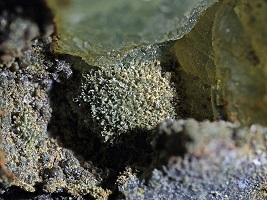
Locality: Merrimack Industrial Interchange road cut, Merrimack, NH
Specimen Size: 6 mm field of view
Field Collected: Tom Mortimer
Catalog No.: u1177
Notes: Pumpellyite confirmed on another specimen (#1150). Here a pumpellyite ball with green prehnite in an amygdule vug.
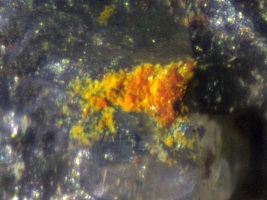
Confidence: 4
Chemistry: Realgar: As4S4 , Orpiment: As2S3
Locality: Parker Mtn. Mine, Center Strafford, NH
Specimen Size: 1 mm field of view. Crusty mass of orpiment-realgar
Field Collected: Phillip Foster
Owner: Tom Mortimer
Catalog No.: 2063 Ex. Phillip Foster micro collection (#26.10=1)
Notes: An article in the December, 1982 issue of "Granite Chips" newsletter of the Southeastern New Hampshire Mineral Club by Phillip Foster reports a find of two "pin-head" sized occurrences of orpiment-realgar from Parker Mtn. This is likely one of those specimens. Harvard examined the specimen, but was non-committal and indicated the sample was too small for analysis. Gunnar Bjareby opined a possible realgar-orpiment ID. The elements in realgar/orpiment are arsenic and sulfur, both of these are present at Parker. I [tm] had discounted a realgar-orpiment occurrence at Parker as "folklore." The matrix for this small crusty bleb is triphylite-ferrisicklerite and appears quite legitmate for a Parker Mtn. piece. An EDS analysis is unlikely due to minimal size of this only known specimen.
A Parker Mtn. Mine species list authored by Art Smith, Rocks & Minerals, July/Aug, 2005, pg. 256, includes orpiment. This Art Smith list is likely responsible for the inclusion of orpiment in mindat.org's Parker Mtn. Mine species list (2015).
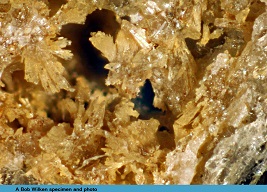
Confidence: 3
Chemistry: {(Mn2+,Ca)}{Mn2+}{(Fe2+,Mn2+,Mg)2}{(Al,Fe3+)2}(PO4)4(OH)2·8H2O
Locality: Chandlers Mill Mine, Newport, NH
Specimen Size: ~ 2 mm field of view
Field Collected: Bob Wilken - 2009
Catalog No.: A Bob Wilken specimen
Notes: A polished grain, semi quantative, EDS analysis (CHM02) gave a chemistry of Mn1.8Ca0.3Fe2Al3.4P4O21.4 (normalized for 4 phosophorus). The best fit for this chemistry is rittmannite. The form and color of these Chandlers Mill crystals are compatable with several photos of this species on mindat.org.
[tm] The IMA chemistry for rittmannite is one of the most complicated I have seen!

Locality: Chandlers Mill Mine, Newport, NH
Specimen Size: 1.5 mm field of view
Field Collected: Bob Wilken
Catalog No.: A Bob Wilken specimen and photo
Notes: Rittmannite (whiteite sub-group) suggested by EDS analyses.
[bw] best as I could determine, Rittmannite was the best option...a relatively new member of the whiteite sub group. Reviewing that decision (2021), I come to the conclusion that it can NOT be Rittmannite because Rittmanite is Mn dominant, (...see the results in the attached spectrum). But, everything else fits. An SEM photo on webmineral clearly shows a crystal termination consistent with these little crystals...one that is eosphorite-group-like. Incidentally Webmineral's formula for Rittmannite does not include any Ca whereas Mindat and IMA's do.
There were no other options for the EDS results beyond Rittmannite and Kingsmountite. Kingsmountite looks more like a gordonite-type xl. So, I decided to check other whiteite subgroup species. Nothing fits there. Several require Mg which this does not show. It seems logical that this should fit in this subgroup somewhere but none of the members quite fit.
Rittmannite chemistry is: {(Mn2+,Ca)}{Mn2+}{(Fe2+,Mn2+,Mg)2}{(Al,Fe3+)2}(PO4)4(OH)2 · 8H2O Web mineral gives an empirical formula as (combining O, omitting H): Mn2FeAl2P4O26 . Analysis chemistry: Mn1.78Fe1.96Al3.35P4O21.4 , normalized for 4 P.
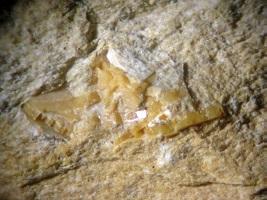
Confidence: 5
Chemistry: K(AlSiO8)
Locality: Streamside Drive residential construction site, Hooksett-Manchester town line, NH
Specimen Size: 9 mm field of view. Tabular sanidine crystals (most on edge) in rhyolite matrix.
Field Collected: Tom Mortimer - 4/17/05
Catalog No.: 2000
Analysis: Sanidine indicated by EDS analysis, BC59. The Sr is a miss-assignment by the element association software. The composition indicated by the EDS analysis is: K0.44Na0.38AlSi2.99O6.67 (Normalized for one Al)
The analysis shows a K-Na alkaline feldspar, potassium dominant. The Na content is a bit high and the K content is a bit low when compared to the webmineral reference analysis for sanidine included in the linked analysis page.
Notes: The crystals are very homogeneous with no evidence of perthitic layering. The rhyolite matrix is appropriate for sanidine crystals.
Sanidine is an IMA valid species. It has not appeared on historical NH mineral species lists, (e.g. Cares, Rocks and Minerals vol. 65, No. 4, pgs 298-299, nor on mindat.org's New Hampshire list.) NH sanidine crystals have been noted in several geologic reports, (e.g. McHone & Sundine, 1995, "Mesozoic Igneous Rocks in Southeastern New Hampshire", http://earth2geologists.net/Publications/McHone_Sundeen_NEIGC95.PDF)
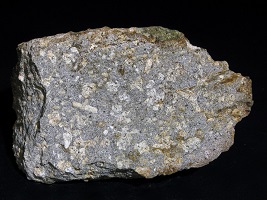
Locality: Bugsmouth Hill, Newton, NH
Specimen Size: 8 cm specimen. Sanidine crystals embedded in trachite.
Field Collected: Tom Mortimer - 10/12/17
Catalog No.: 2079
Notes: Reference: McHone and Sundeen, Mesozoic and Igneous Rocks in Southeastern New Hampshire NEIGC95 (1995) pg. C2-17, describes the occurrence at Bugsmouth Hill of a fine-grained rhyolite with small alkali feldspars.
A January 2018 XRD analysis supported the sanidine identification. A "disordered albite" also gave a good correlation with this XRD plot per the XRD analyst.
A January 2018 polished grain EDS analysis indicated a chemistry of
(Na0.49K0.37Ca0.19)Σ=1.05(Al0.97Fe0.03)Σ=1.00Si3.01O9 normalized for three atoms of Si.
A second 2018 polished grain EDS analysis indicated a chemistry of
(Na0.65K0.05Ca0.26)Σ=0.96(Al1.36Fe0.04)Σ=1.40Si3O9 normalized for three atoms of Si.
This analysis did not have a sodium contamination issue.
The Handbook of Mineralogy gives a sanidine analysis of
(Na0.56K0.40Ca0.10)Σ=0.97(Al1.71Fe0.05)Σ=1.76Si3O8.7 .
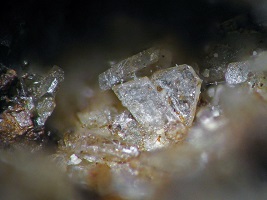
Locality: Bugsmouth Hill. Newton, NH
Specimen Size: 1.7 mm field of view
Field Collected: Tom Mortimer
Catalog No.: u2098
Notes: Visual identification by Tom Mortimer. Vug in rhyolite makes sanidine the most likely species.